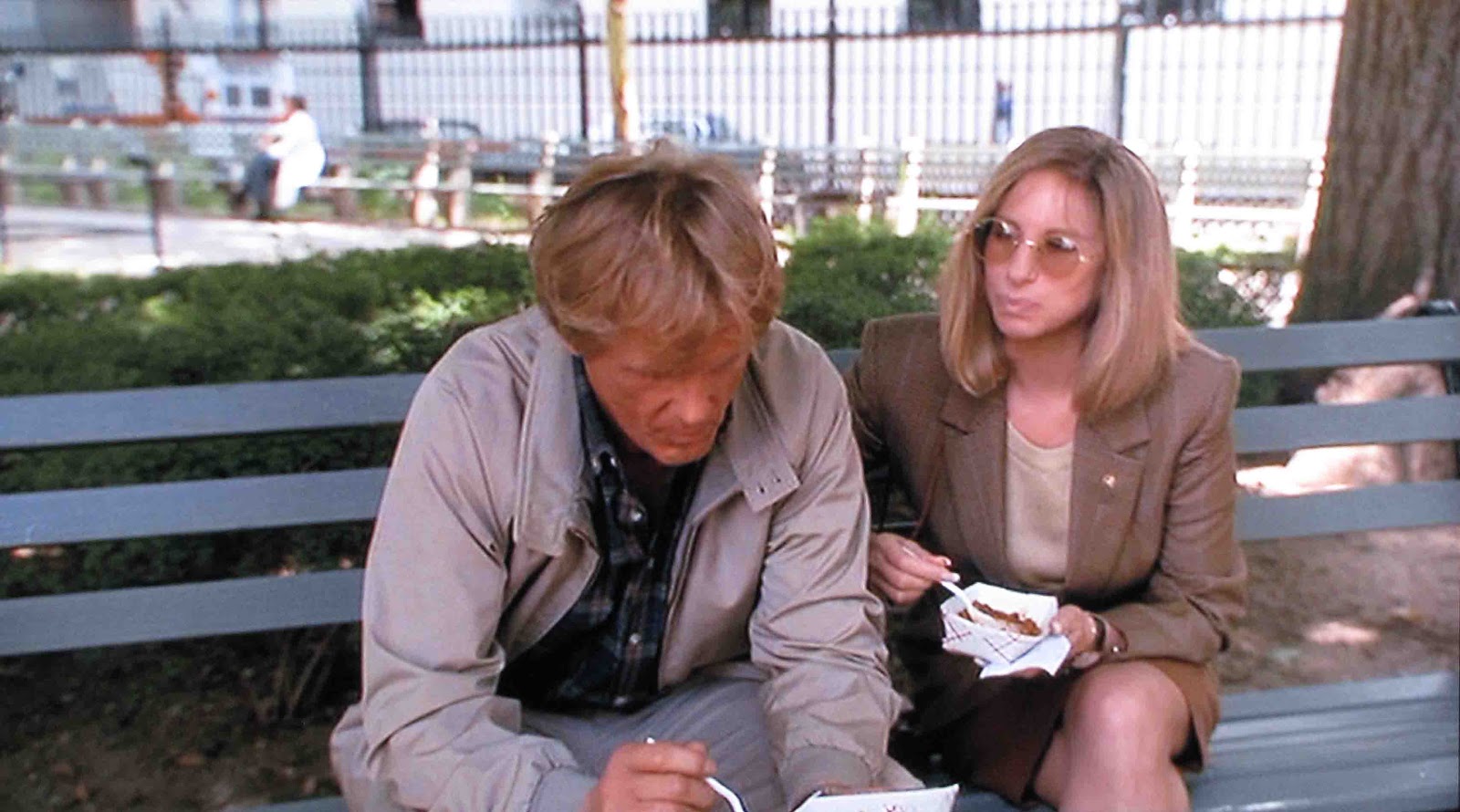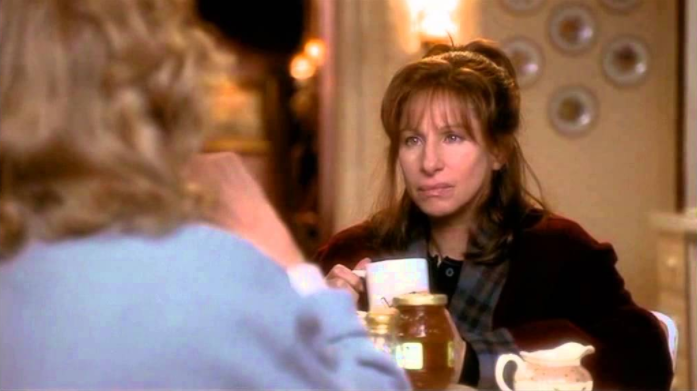
Barbra Streisand’s third directorial outing, The Mirror Has Two Faces (1996), thought of as a typical, self-indulgent romantic comedy, was not received favourably. A loose remake of the 1959 French film of the same name by André Cayette, Streisand’s version concerns the romance of a frumpy professor (played by the director herself) and her metamorphosis into a beautiful woman in response to her stifling husband. On the surface, The Mirror Has Two Faces could be read as a conventional makeover movie. With the transformation montage (covering diet, makeup, hair and wardrobe) and life-changing, jaw-dropping reveal, the trajectory of Streisand’s heroine could come from any sexist rom-com, paired with the narcissism of director-as-screen-beauty. But Streisand as director has always been concerned with the makeover in the feminist project of her filmmaking. By considering the makeovers in Streisand’s first two films, Yentl (1983) and The Prince of Tides (1991), and putting them into conversation with The Mirror Has Two Faces, it is clear that rather than accepting sexist convention, Streisand is manipulating the makeover in order to subvert it.
Streisand’s directorial debut follows the eponymous Yentl (Streisand) in turn-of-the-century Poland who has been secretly educated by her father, despite education being customarily denied to women. When her father dies, Yentl decides to continue her education by dressing as a man in order to enter the yeshiva (Jewish college). The film offers two makeovers. The first is when Yentl transforms herself into a boy named Anshel. After her father’s funeral, Yentl, disheveled, walks through a room towards a mirror covered with black cloth, as is the custom when sitting shiva The cloth is removed to reveal the glass’ cracked surface which fractures Yentl’s face as she takes a lock of hair and cuts it. Our look at this transformation ends here, as the film cuts ahead to reveal the fully-formed Anshel.
Taking the typical elements of the makeover (the sad, unkempt yet determined girl transformed into something new, paired with the disruption of her image in preparation for a clearer version of herself), Streisand replicates the abrupt changes in films like Sabrina (1954) or Roman Holiday (1953) where a haircut, taking place off-screen, revives characters (both played by Audrey Hepburn) in startling reveals. The use of ellipsis rather than makeover montage recalls the reintroduction of Hepburn in these films, her short hair signifying a modern chicness. Here, Streisand cuts the same way, presenting herself suddenly post-makeover in a new appearance which equally signifies a modern change, but her pixie haircut is practical rather than stylish, a necessary outfit to navigate the patriarchal structures that deny her ambitions.

Later in the film, when Streisand shoots her makeunder (in which Anshel takes off his clothes to become Yentl again), the montage is perhaps more typical of the cinematic makeover. Cutting between shots of Yentl gazing upon herself in the mirror (this time not cracked), as she undresses, the camera moves languidly along her body. However, Streisand insistently subverts a conventional male gaze. As Yentl sings of her desire for a fellow pupil, the camera moves from her face to her breasts. All we see are her bindings; her nudity is denied to us while emphasizing her struggle. When Streisand films Yentl’s legs, moving up towards her thighs, our gaze is again thwarted as she covers herself with a nightgown before we are able to see her fully. But it is the contrast between this re-transformation, where Yentl’s body is protected from our view by Streisand’s costuming and constantly moving camera, and the preceding scene, where her classmate’s glistening naked body is filmed fully and without looking away (the camera maintaining its gaze upon him even when Yentl averts her eyes), which makes Streisand’s emphasis on Yentl’s agency and desire rather than her objectification more meaningful. In both instances, Streisand uses masculine cinematic convention (the generic makeover, the male gaze) in a subversive way to empower her protagonist, focusing on physical transformation which belies the marginalized yet diverse desires (from academic to sexual) of a woman.
Again eschewing the conventions of the makeover, Streisand focuses on the transformation of a male character in The Prince of Tides. The film follows Tom (Nick Nolte) as he travels to New York after his sister Savannah is hospitalized for attempting suicide. Summoned by Dr. Lowenstein (Streisand), Savannah’s psychiatrist, to give insight into why Savannah has again attempted to take her life, Tom is jaded and depressed, but decides to stay in the city to help. It is then through the aid of his sister’s psychiatrist that Tom completes his transformation.
Streisand uses masculine cinematic convention (the generic makeover, the male gaze) in a subversive way to empower her protagonist, focusing on physical transformation which belies the marginalized yet diverse desires (from academic to sexual) of a woman.
At the beginning of the film, Tom is detached. He is unfulfilled, hates his mother, and has a cold relationship with his wife. But in addition to his inner turmoil, he externalizes his distress in ways typically ascribed to women in film: through troubles with beauty and romance. Upon arrival in New York, Tom’s friend Eddie (George Carlin) comments: “You look terrible. You’re not even cute anymore.” Adding to this is the problem of love: Tom’s wife, neglected as a result of his emotional crisis, seeks comfort in an affair. His love life in a rut and looking bedraggled, Tom is like the typical makeover-ready heroine. The difference is how his transformation occurs, and why.
Makeovers for men and women are often depicted quite differently. For women characters, there is a focus on their allure to men. Their plainness is rectified, making way for men to be able to love them. Though occasionally this comes with the improvement of other qualities (such as Melanie Griffith’s career confidence in Working Girl or Audrey Hepburn’s education in My Fair Lady), the makeovers usually play as Cinderella stories, paving the way for a romance that takes precedence in the now-beautiful woman’s life. Frequently for men, the transformation is either presented comedically (such as Jerry Lewis in The Nutty Professor or The Patsy), or with an emphasis on adorning that which is already perfected (Zac Efron’s character in Seventeen Again must change his clothes to enhance the looks that others know he possesses, but the purpose isn’t to gain acceptance by women).
In The Prince of Tides, Streisand manipulates the trope once again for her protagonist. Rejecting the typical masculine makeover, Streisand places Tom within the feminine role: unlucky in love, not looking great, Tom needs something to reinvigorate him. As opposed to a direct flip of a misogynist trope, Tom’s makeover is afforded depth and sensitivity. He begins to look better as he heals his psychological trauma with the help of Dr. Lowenstein while also gaining her love and affection. Having suppressed his trauma, it is with the guidance of Dr. Lowenstein, not as a psychiatrist but as a significant relationship in his life (which comes with the benefit of psychological expertise) that Tom gains the support he needs to begin to heal.

Streisand presents both characters as benefitting from their relationship, both revived through mutually expressed care, but she keeps Dr. Lowenstein in a position of power. Though aiding the more vulnerable Tom, Streisand represents the doctor as in control: Tom needs her more than she needs him. Giving space to Tom to explore the trauma of sexual violence in his past, something rarely depicted with respect and empathy in cinema, Streisand manages to make both her protagonists fully developed. Dr. Lowenstein is never flattened into a Manic Pixie Dream Girl care-giver.
While Tom is given a superficial feminine makeover as the base for his more complex emotional transformation, Streisand eschews stereotypical feminine vulnerability by giving Dr. Lowenstein power and capability, leaving her in a position of strength rather than making her a figure of unrewarded emotional labour. Like in Yentl, the makeover is a necessity for Tom (his looks and love life are synonymous with his psychological health, and in the construction of him as a fully formed character). Subverting the trope by displacing it onto a man, while letting it flourish into an all-encompassing mode of guided self-care, The Prince of Tides maintains the love and beauty element of the makeover while pushing it much further.
The most conventional of Streisand’s makeovers is in The Mirror Has Two Faces. The film follows Rose (Streisand), a “plain” professor. She marries Gregory (Jeff Bridges), a math teacher who, hurt by love and finding sex to be a distraction, wants a platonic marriage. Lonely and equally hurt, Rose accepts him, but becomes dissatisfied with their degrading, sexless marriage and the control Gregory has over it. When Gregory leaves for a conference, Rose undertakes her own makeover, transforming herself into a new woman by the time he returns. With newfound confidence, Rose gains independence, leaving Gregory and only agreeing to reunite with him when he can accept her as a woman and romantic equal, rather than as the friendly sexless companion he viewed her as before.
Of Streisand’s three films, The Mirror Has Two Face’s makeover is the most straightforward. Unlike the gender switching and explicit goals of her previous two films, here the woman changes her looks and gains love. Rose, dressed in baggy sweaters, hair limply covering the parts of her face not already hidden by glasses, begins the film in a typically dowdy pre-makeover state. Her transformation is equally typical. Presented to us in chic dresses, tastefully accessorized, wearing contact lenses, and a bouncy perm, Rose looks the part of a new woman.

Like in Streisand’s previous films, appearance is parallel to independence, ambition, and healing. Appearance is a sublimation of Rose’s confidence, which breaks through as part of her makeover. This is made explicit when Rose briefly goes back to her ex, Alex (Pierce Brosnan). As he expresses that he loves her now that she is conventionally attractive, she states she had always placed him above herself, never considering her own needs. In an emotional speech, she tells him: “I never thought I was good enough for you.” When Alex responds that she is, she replies, “But Alex, you’re not good enough for me!” Bluntly, Streisand has Rose come to terms with her own self-worth, having it replace her self-denigration. And by giving her heroine a happy ending, Streisand gives Rose the romance she desires with Gregory, but only after he compromises for her. Knowing her value, it is Gregory who must accept his mistakes and make changes for her in order to be in her life.
The Mirror Has Two Faces consciously plays with the cinematic makeover, but more thoroughly than in Yentl or The Prince of Tides. During the married couple’s first night together, Rose suggests watching a VHS copy of Now, Voyager, Bette Davis’ iconic makeover film. In Now, Voyager, protagonist Charlotte (Davis) begins much like Rose: unadorned, in matronly clothes and glasses; she then appears after her makeover in fashionable outfits, with a new sense of confidence. Charlotte expresses this confidences much like Rose does, by breaking away from her overbearing mother and finding romance. But Charlotte never has the love she desires. The object of her affection, still married, cannot leave his wife and Charlotte concedes to not “ask for the moon” when they “have the stars.” An incomplete love story where the physical and emotional transformations only pay off halfway, Now, Voyager is a great weepy, but lacks the empowerment that Rose experiences by the end of The Mirror Has Two Faces.
Streisand has proven herself to be well-versed in the trope of the cinematic makeover, and in distilling her cinematic knowledge as well as refining the themes that she worked through in her first two films, she creates the culmination of her work with the makeover trope in The Mirror Has Two Faces. Throughout her oeuvre, her makeovers focused on the physical transformation of characters to empower them: with a change in looks they gain confidence, heal and achieve their ambitions. They realise their value as people and act upon it. They use transformations to combat patriarchal institutions which oppress them. By consistently confronting the makeover throughout her oeuvre, Streisand employs the traditionally sexist trope to make her characters powerful within feminist narratives that look to give voice and space to marginalized figures. Potentially read as a basic sexist makeover, where the woman is finally attractive enough for her mate, The Mirror Has Two Faces is rather an informed look at beauty and transformation, how they play into a woman’s confidence, and the importance of assertions of self-worth for carving out the space one wants in life. The end product of the more explicitly subversive makeovers of Yentl and The Prince of Tides, the place of The Mirror Has Two Faces within Streisand’s directorial oeuvre reveals its feminist project. It is never about her characters being “hot all along,” (even if they are): it is about individual self-discovery through the disruption of patriarchal power.





